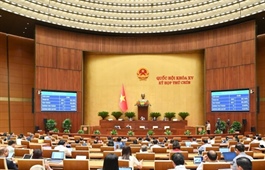Stagnant renewables strategy must be overturned
Stagnant renewables strategy must be overturned
Vietnam’s ambitious target to accelerate renewable energy deployment is facing mounting implementation hurdles, raising concern among investors and experts over feasibility and policy readiness.
According to Nguyen Thai Ha, CEO of T&T Energy Group, if Vietnam manages to achieve the proposed wind power capacity outlined in Power Development Plan VIII (PDP8), it could help the country cut between 64 and 110 million tonnes of CO2 emissions annually, accounting for 6.9-11.9 per cent of the national total.
However, he noted that realising this goal, particularly for onshore and offshore wind (OSW), remains a distant prospect due to regulatory, technical, and financial challenges.
“The regulatory framework for OSW remains vague, with no clear spatial marine planning or procedures for licensing surveys and development,” Ha said. “There are also overlapping claims over sea areas, and no official announcement of designated offshore zones or related criteria, all of which delay investor preparations.”
In addition, Ha pointed out the lack of a pricing mechanism for OSW, despite proposals submitted by Vietnam Electricity (EVN). “The absence of a price framework makes it impossible to assess financial viability,” he added.
EVN estimates the investment cost for OSW to be around $3.57 million per MW, significantly higher than onshore wind or other renewable sources like solar and biomass. Given the capital intensity and the absence of financial support mechanisms, investors are cautious about entering the offshore segment.
Grid infrastructure also poses a major barrier. In many regions with strong wind resources, the grid has not been upgraded to accommodate new capacity, leading to fears of curtailment or transmission bottlenecks. Ha stressed that Vietnam still lacks a planned undersea cable network to connect OSW farms to the national grid, further complicating deployment.
The Ministry of Industry and Trade recently issued a new price ceiling for onshore and nearshore wind power applicable across the three regions: VND1,959.4/kWh in the north, VND1,807.4/kWh in the central region, and VND1,840.3/kWh in the south. For nearshore wind, the uniform ceiling is VND1,987.4/kWh.
These prices apply only to projects still undergoing procedures to sign power purchase agreements (PPAs) with EVN. Since the expiry of the feed-in tariff (FiT) mechanism in 2021, numerous wind projects have been left in limbo due to a lack of legal grounds for price negotiations.
However, OSW remains outside the scope of these new pricing guidelines. The PDP8 aims for 26,000–38,000MW of onshore and nearshore wind capacity by 2030, and between 6,000–17,000MW OSW between 2030 and 2035. With only just over 5,900MW of wind installed by the end of 2024 and no operational OSW farms, the gap is substantial.
Development for solar and onshore wind has also slowed. According to a representative of an investor currently exploring projects, Decree No.56/2025/ND-CP now requires public bidding for power projects, including solar and wind, regardless of land ownership.
“This contradicts the Electricity Law 2024, which states that if the land has already been zoned for the correct purpose, then no bidding is required,” the investor said. “The decree is stricter than the law itself. If the land is privately held, a winning bidder may not be able to access it. This regulation must be revised if we want projects to move forward.”
Another hurdle stems from ongoing administrative restructuring. As several provinces undergo mergers or jurisdictional changes, local socioeconomic plans and spatial strategies will be revised, further delaying renewable energy development until local governance stabilises.
The stagnation has been evident since 2021, when Vietnam’s renewable energy boom began to cool following the end of the FiT era. The lack of a timely replacement mechanism has eroded investor confidence and delayed numerous projects.
“The post-FiT pricing framework remains unclear,” noted Assoc. Prof. Dr. Dang Tran Tho, director of the Institute of Energy Technology at Hanoi University of Science and Technology. “The shift from FiT to auction-based or PPA-based models lacks transparency in pricing methodology, risk-sharing, and implementation timelines. Moreover, current PPAs are legally weak, offering no payment guarantees or policy-risk protections, which deters long-term international finance.”
He stressed that the lack of dedicated laws on renewables or the energy transition compounds the problem. “Despite the adoption of the PDP8 and Vietnam’s net-zero pledges, there is still no overarching legal foundation for renewable energy. Policy fragmentation and weak legal enforceability make consistent implementation across central and local levels difficult,” Tho said.
- 09:52 17/06/2025























